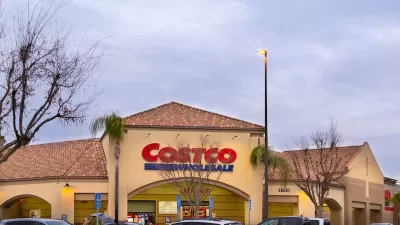To deal with the problem of vacant big-box stores that have proliferated across the country, one Milwaukee suburb is levying a fee on developers to help pay for demolition. Other cities are exploring similar options.
"Like many communities across the country, Wauwatosa has taken steps to protect itself against so-called ghost boxes, the hulking remains of what are often big box stores left vacant when retailers downsize or relocate.
Many see measures such as Wauwatosa's, which assesses developers a fee that can be used for demolition if needed, as counterproductive to attracting new business.
But recent announcements of store closings by Home Depot and Linens 'n Things - and concerns that more could follow - have some economic development officials reconsidering."
"Wauwatosa's provision, adopted as part of its big-box ordinance in 2005, requires developers of buildings 50,000 square feet and larger to set aside 20 cents a square foot in the city's land conservation fund - about $28,000 in Lowe's case - which can be tapped to raze the building if it sits empty for more than a year.
"This is exactly the climate we were anticipating when we adopted this," Wauwatosa Community Development Director Nancy Welch said shortly after Home Depot announced this month that it would close 15 stores, including three in Wisconsin.
Widely criticized in the development community at the time, Wauwatosa's provision has been touted by the American Planning Association as one of the innovative ways communities can protect themselves if a retailer departs.
Others include higher architectural standards that make buildings easier to reuse; requiring developers to take out demolition bonds; and banning clauses in leases that prohibit the owner of a building, once vacated, from renting it to a retailer's competitor."
FULL STORY: Razing fees for big box stores get 2nd look

Maui's Vacation Rental Debate Turns Ugly
Verbal attacks, misinformation campaigns and fistfights plague a high-stakes debate to convert thousands of vacation rentals into long-term housing.

Planetizen Federal Action Tracker
A weekly monitor of how Trump’s orders and actions are impacting planners and planning in America.

San Francisco Suspends Traffic Calming Amidst Record Deaths
Citing “a challenging fiscal landscape,” the city will cease the program on the heels of 42 traffic deaths, including 24 pedestrians.

Half of Post-Fire Altadena Home Sales Were to Corporations
Large investors are quietly buying up dozens of properties in Altadena, California, where a devastating wildfire destroyed more than 6,000 homes in January.

Opinion: What San Francisco’s Proposed ‘Family Zoning’ Could Really Mean
Mayor Lurie is using ‘family zoning’ to encourage denser development and upzoning — but could the concept actually foster community and more human-scale public spaces?

Jacksonville Launches First Autonomous Transit Shuttle in US
A fleet of 14 fully autonomous vehicles will serve a 3.5-mile downtown Jacksonville route with 12 stops.
Urban Design for Planners 1: Software Tools
This six-course series explores essential urban design concepts using open source software and equips planners with the tools they need to participate fully in the urban design process.
Planning for Universal Design
Learn the tools for implementing Universal Design in planning regulations.
Gallatin County Department of Planning & Community Development
Heyer Gruel & Associates PA
JM Goldson LLC
City of Camden Redevelopment Agency
City of Astoria
Transportation Research & Education Center (TREC) at Portland State University
Jefferson Parish Government
Camden Redevelopment Agency
City of Claremont





























